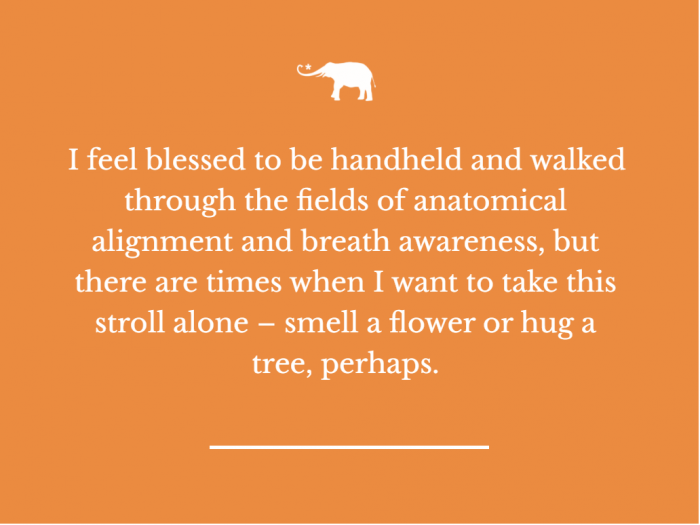A few months back, I had shared a write-up on Instagram that might have possibly hurt the sentiments of Ashtanga yogis and unintentionally undermined the merit of the Vinyāsa tradition. “There is a lot of movement, movement from one pose to another. While that definitely makes the body flexible, the mind is unable to become still. And by the time Shavasana arrives, you are way too exhausted to feel the inner peace. As your practice deepens and matures, you want to stay instead of moving,” it stated.
Now this was the time I paraded around as an imperious Iyengar student, ever ready to strike down another school unhesitatingly. A dear friend, who I reckon had left her heart behind in Mysore after completing her Ashtanga TTC, was quick to retort. “I truly feel we must not comment about any other styles of yoga if we haven’t practised them for a prolonged period of time. Yoga doesn’t belong to anyone,” she pointed out. I’m unsure if it was my ego, resentment or both, but I felt like someone had kicked me in the stomach. “Was I really as tender and tolerant as I claimed myself to be?” I wondered.
The first thing we learn in any yoga class, and especially an Iyengar Yoga class, is Samasthiti, the balanced stillness and grounding in the Mountain pose and the experience of equanimity in thoughts, in actions and in vibrations. How then can one style of yoga be regarded as superior to another? There are all sorts of people in this world and while some may be mesmerised by slow-paced sessions and moving meditations, the others might want to wash away their inner screams with movement.
Just then, I was reminded of my first ever Iyengar class. Naïve as a lamb, I told my teacher than I had recently completed my TTC. “But there’s still a long way for me to go. I want to explore and expand my intelligence,” I beseeched, my voice laced with humility. My teacher scoffed momentarily and later directed all the questions that were asked in class on that particular day to me. The slaughter was inevitable, but I showed up in class the day after that, and the day after that.
Iyengar Yoga isn’t something you can learn overnight. Even over a thousand nights. “Lengthen the calf muscle. Open the back of the knee. Dig your heel into the ground. Let the stomach skin rotate to the left. Allow both sides of the trunk to lengthen. Push the chin towards the pit of the throat,” the teacher will command, and yet you’ll never get your Trikonasana right. Not in this lifetime.
Iyengar Yoga is all about eye for detail. The slightest change in the placement of your block can make an enormous difference to your sensitivity. In one of his discourses, Guruji’s son, Shri Prashant Iyengar, emphasises how ‘compromising’ is not allowed in Iyengar yoga. “No compromising in the back, dorsal, sacrum, abdomen, and leg parts. From the socket to the soles of the feet – no compromise. Stringent conditions have to be imposed.”
Iyengar Yoga is continuous intructions. Don’t get me wrong, I feel blessed to be handheld and walked through the fields of anatomical alignment and breath awareness, but there are times when I want to take this stroll alone. It would be nice if I could have some space to smell a flower, hug a tree, perhaps. I don’t want to be bombarded with instructions all the time. There are moments when I don’t want to exhale profoundly, not lift the top ribs or grip by knee caps. And yet that doesn’t make me any less of a good yoga practitioner.
The props are another ball game. And trust me, your yoga block is there for you when you need it the most. The release one feels in a rope-supported Adho Mukha Svanasana cannot be expressed in words, just like the release one feels in the restorative version of Supta Baddhakonasana.
I remember my first Iyengar class at the Institute when my teacher ordered everyone to go to the ropes, and I’ve never felt so clueless, because most students in class darted to the walls to reserve their own space for Rope Shirshasana. That these students wanted to absorb the physical culture was commendable, but I couldn’t see the calm that I was looking for in their eyes. They weren’t ready to offer their hand to a beginner.
Zoom has allowed me to learn from the crème de la crème of Iyengar teachers. And yet, there have been teachers who haven’t accepted me as their student because I was a teacher myself, as well as teachers who have walked out of the class the minute the time was up. No questions were entertained or answered during or after class.
A year or two back, I was willing to sell my soul to become an internationally recognised Iyengar teacher. A process that’s a well-kept secret, because it’s the teacher who’ll pick you once you have ripened in your practice. But today, I don’t feel the need to, because I don’t want to be like a majority of them – unapproachable and impertinent. I don’t want to be a brand either. I am here to gather and share my knowledge. I want to be there for everyone who needs me. Like Guruji himself.
No matter how slippery or mercurial the path of yoga might be, I want to turn it into an adventure for my students. Living like a tribe on some days, and exploring our own path on other. All of us blooming like wild flowers under the sun, and sparkling like the waters of a tranquil pond under the moon. We’ll be the Ha and the Tha – complementing, balancing and evolving. Together.







Read 1 comment and reply